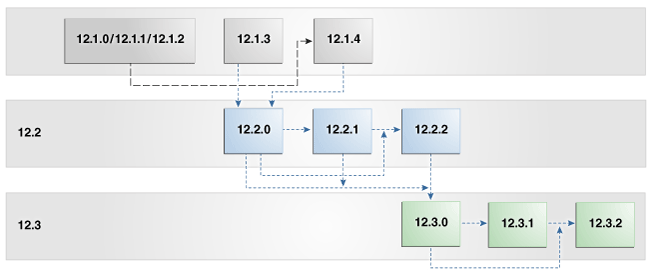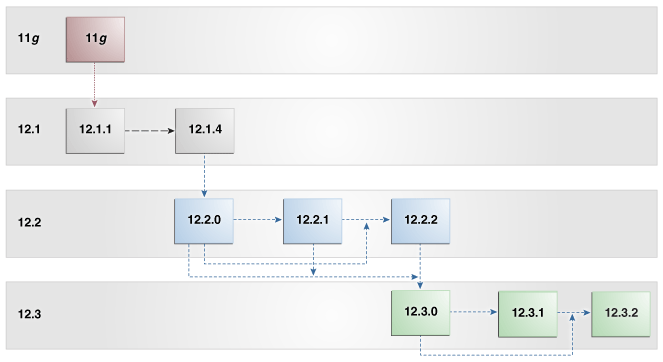1 Get Started with Upgrade
You can upgrade the Oracle Enterprise Manager Ops Center.
This guide explains the prerequisites necessary to upgrade to Oracle Enterprise Manager Ops Center 12c Release 3 Update 2 (12.3.2.0.0).
Note:
If you use Ops Center to monitor Oracle SuperCluster, do not upgrade to Oracle Enterprise Manager Ops Center 12c Release 3 (12.3.2.0.0). Oracle SuperCluster is supported only by a subset of Oracle Enterprise Manager Ops Center versions. Refer the Oracle Enterprise Manager Ops Center Certified Systems Matrix to verify if Oracle SuperCluster platform is supported by Oracle Enterprise Manager Ops Center version that you use.
This chapter includes the following sections:
Versions Supported for Upgrade
Before planning your upgrade, you may need to perform multiple upgrades to reach the latest version.
Read this section carefully before planning your upgrade. This section details the supported upgrade paths.
The following topics are covered:
Upgrading From Version 12.3
Use the following upgrade path when you are upgrading from Oracle Enterprise Manager Ops Center 12.3.0 to later versions.
If you are currently using version 12.3.0 or 12.3.1, you can upgrade directly to version 12.3.2.
Upgrading From Version 12.2
Use the following upgrade path when you are upgrading from Oracle Enterprise Manager Ops Center 12.2 to later versions.
If you are currently using version 12.2.0, 12.2.1, or 12.2.2, you can upgrade to version 12.3.0, and finally upgrade to the latest version.
Figure 1-1 Supported Upgrade Paths From Version 12.2

Description of "Figure 1-1 Supported Upgrade Paths From Version 12.2"
Upgrading From Version 12.1
Use the following upgrade path when you are upgrading from Oracle Enterprise Manager Ops Center 12.1 to later versions.
If you are currently using Oracle Enterprise Manager Ops Center version 12.1, you can upgrade to version 12.1.3 or 12.1.4, then upgrade to version 12.2.0, then upgrade to version 12.3.0, and finally upgrade to the latest version.
Figure 1-2 Supported Upgrade Paths From Version 12.1

Description of "Figure 1-2 Supported Upgrade Paths From Version 12.1"
You must upgrade in this order:
-
If you are using version 12.1.0, 12.1.1, or 12.1.2, upgrade to version 12.1.4.0.0 as described in Related Resources for Upgrade.
-
Upgrade to version 12.2.0.0.0 as described in this guide.
-
Upgrade to version 12.3.0.0.0 as described in this guide.
-
Upgrade to version 12.3.2.0.0 as described in this guide.
Upgrading From Version 11g
Use the following upgrade path when you are upgrading from Oracle Enterprise Manager Ops Center 11g to later versions.
If you are currently using Oracle Enterprise Manager Ops Center 11g, you can upgrade to version 12.1.1, then upgrade to version 12.1.4, then upgrade to version 12.2.0, then upgrade to 12.3.0, and finally upgrade to the latest version.
Figure 1-3 Supported Upgrade Paths From Version 11g

Description of "Figure 1-3 Supported Upgrade Paths From Version 11g"
You must upgrade in this order:
-
Upgrade to version 12.1.1.0.0 as described in Related Resources for Upgrade.
-
Upgrade to version 12.1.4.0.0 as described in Related Resources for Upgrade.
-
Upgrade to version 12.2.0.0.0 as described in this guide.
-
Upgrade to version 12.3.0.0.0 as described in this guide.
-
Upgrade to version 12.3.2.0.0 as described in this guide.
Planning the Upgrade
Upgrading to a newer version of Oracle Enterprise Manager Ops Center can change the system requirements and affect existing settings and data.
Take the following steps to plan your upgrade:
-
Review the pre-installation requirements and known issues. See Related Resources for Upgrade for more information on the pre-installation requirements and known issues.
-
Verify that your system meets the operating system requirements. See Related Resources for Upgrade for more information on verifying the operating system requirements.
-
Verify that your system meets the system requirements, since some system requirements have changed. See Related Resources for Upgrade for more information on verifying the system requirements.
You can use the OCDoctor to check system requirements and identify and address some known issues. See Related Resources for Upgrade for more information on using OCDoctor.
-
Check if there are any traces from previous Enterprise Controller installation or upgrade procedure. Remove the
/tmp/CVU_12.1.0.2.0_oracleocdirectory and/tmp/CVU_11.2.0.4.0_oracleocdirectory before installing or upgrading the Enterprise Controller. -
If you made changes to the
.uce.rcfile, the upgrade erases your changes. Copy your changes to the.uce.rcfile before beginning the upgrade. -
If you replaced the self-signed web server certificate for the Enterprise Controller, the upgrade erases your web server configuration changes, and might erase the certificate. See Oracle Enterprise Manager Ops Center Security for information on replacing the self-signed web server certificate. Copy the certificate to a secure temporary location before beginning the upgrade. After the upgrade, reapply your configuration changes and copy the certificate to its original location.
-
If your Enterprise Controller is installed on Oracle Solaris 11, your Oracle Solaris 11 publisher must point to an Oracle Solaris 11 repository that contains the specific version of Oracle Solaris 11 installed on the Enterprise Controller before you begin the upgrade. If not, the upgrade process does not proceed.
-
While installing or upgrading Enterprise Controllers with a colocated Oracle 12c database, set either the
zfs_arc_maxparameter value or theuser_reserve_hint_pctparameter value in the/etc/systemfile or a configuration file located in the/etc/system.ddirectory for Oracle Solaris 11.x platforms. You can use the OC Doctor to calculate the parameter value. Once the parameter value is set, restart the system for the configuration to take effect.At the beginning of the installation or upgrade of an Enterprise Controller, if the parameter value is not set, then the install or the upgrade wizard provides information on the parameter value to be set and how to set the parameter value.
-
If you are upgrading to version 12.2.2.0.0 or 12.3.0.0.0, and are using the embedded database, you must download installation bundles for Oracle Database version 11.2.0.4, as the Oracle Enterprise Manager Ops Center upgrade also upgrades the embedded database. The download procedure is described in the Before You Begin section in each upgrade chapter.
Note:
Due to improvements to vServer management, Oracle VM Server for SPARC vServer templates from version 12.1.4.0.0 or earlier will not function in version 12.2.0.0.0 or later and must be recreated. In addition, a user with the Cloud Administrator role must configure at least one vNet as a boot network before creating any new vServers.
-
If you are upgrading to version 12.3.1.0.0 or later, and are using the embedded database, you must download installation bundles for Oracle Database version 12.1.0.2, as the Oracle Enterprise Manager Ops Center upgrade also upgrades the embedded database. The download procedure is described in the Before You Begin section in each upgrade chapter.
-
Any Oracle Enterprise Manager Ops Center IDRs that are installed prior to upgrading are automatically removed during the upgrade. If the upgrade fails and a rollback takes place, these IDRs must be manually re-installed. When the upgrade is successful, these IDRs will no longer be needed and no further action is required. The Ops Center IDRs uninstalled are listed in the upgrade log.
-
Do not upgrade the Java version on Oracle Solaris 10 Control Domains or Logical Domains that have LDOM Manager version 3.2 or earlier installed. If you have upgraded the Java on these systems to version 1.6.0_101 or higher, downgrade to Java 1.6.0_95.
Upgrading Your Environment
There are several upgrade procedures available for a variety of environments.
Several factors will determine the procedure that is most appropriate for your environment. Table 1-1 shows the relevant chapter for you based on your environment and your preferences for the upgrade. Each chapter is a complete upgrade procedure.
Environments with a single Enterprise Controller use a separate procedure from environments with Enterprise Controller High Availability.
You can perform upgrades through the user interface or from the command line.
Table 1-1 Upgrading Your Environment
| Enterprise Controller High Availability? | User Interface or Command Line? | Chapter |
|---|---|---|
|
Yes |
User Interface |
Chapter 2, Upgrading an HA Environment Using the User Interface |
|
Yes |
Command Line |
Chapter 3, Upgrading an HA Environment Using the Command Line |
|
No |
User Interface |
Chapter 4, Upgrading a Single EC Environment Using the User Interface |
|
No |
Command Line |
Chapter 5, Upgrading a Single EC Environment Using the Command Line |
Related Resources for Upgrade
You can view the Oracle Enterprise Manager Ops Center documents for additional information.
For more information, see these Oracle resources:
-
For information on upgrading to version 12.1.1 and version 12.1.4, see Version 12.1 Administration Guide
-
For information on pre-installation requirements and known issues, see Oracle Enterprise Manager Ops Center Release Notes
-
For information on verifying the operating system requirements, see Oracle Enterprise Manager Ops Center Certified Systems Matrix
-
For information on verifying the system requirements, see Oracle Enterprise Manager Ops Center Installation for Oracle Solaris Operating System or Oracle Enterprise Manager Ops Center Installation for Linux Operating Systems
-
For information on Oracle Solaris OS installation procedure, see Oracle Enterprise Manager Ops Center Installation for Oracle Solaris Operating System
-
For information on Linux OS installation procedure, see Oracle Enterprise Manager Ops Center Installation for Linux Operating Systems
-
For information on OCDoctor, see Oracle Enterprise Manager Ops Center Administration
-
To download OCDoctor, go to
https://updates.oracle.com/OCDoctor/OCDoctor-latest.zip -
For information on vServer Management, see Oracle Enterprise Manager Ops Center Virtualization Reference
-
The Oracle Enterprise Manager Ops Center Documentation Library is located at
http://docs.oracle.com/cd/E59957_01/index.htm -
For more information on product administration, see
http://docs.oracle.com/cd/E59957_01/nav/administer.htm -
For end-to-end examples, see the Deploy How To library at
http://docs.oracle.com/cd/E59957_01/nav/deploy.htmand the Operate How To library athttp://docs.oracle.com/cd/E59957_01/nav/operate.htm -
For more information on Enterprise Manager Ops Center, see the Ops Center blog at
https://blogs.oracle.com/opscenter/
